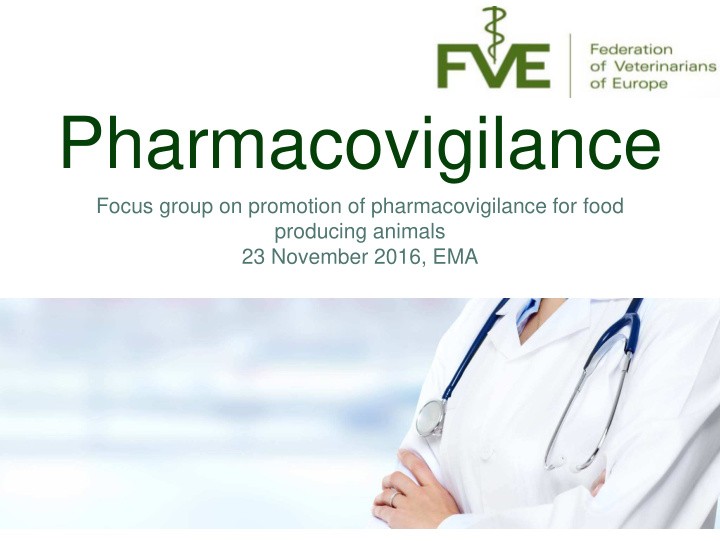



Pharmacovigilance Focus group on promotion of pharmacovigilance for food producing animals 23 November 2016, EMA
Survey To survey reporting behavior of veterinarians What we wanted to learn • What, why and when do or don’t vets report • How much feedback do they receive • Explore ways to improve the pharmacovigilance system Via • Online survey run in all EU ( ≠ languages) Timeframe • Launched survey 30/9/2015 • Closed survey 31/12/2015 • Analyzed by March 2016 • Planned report submission summer 2016
SURVEY RESULTS THE SURVEY WAS COMPLETED BY 3545 PRACTITIONERS
European Countries Which country are you from? 700 668 525 350 357 300 271 175 192 180 180 133 129 124 97 89 83 73 66 63 52 0 > 50 responses
Respondents Information Employment Role Years of Gender 7% 5% Experience ♂ ♀ 14% [PE [PE < 15 50.1 > 15 RC RC year year % ENT ENT s s A… AG 47.1 52.9 24.3 E] % % % Companian Animals Mixed practice Similar % as our Food-producing animals demographic survey, so Other Equine practice representative
Frequency of seeing adverse reactions or events 75% 58% 60% Very frequently (in >10%) Frequently (5%-10%) Sometimes (1%- 5%) 45% Rarely (<1%) Never 32% 30% 15% 1-5% <1% 5% 4% 1% 0% ALL 58% see adverse events rarely (<1%), 32% sometimes (1%-5%)
Frequency of observing lack of efficacy (Mainly) companion animal practice 47% 40% 3% (Mainly) food-producing animal practice 15% 49% 31% 4% Equine practice 8% 48% 41% 3% Mixed practice 12% 48% 35% 4% Other type of veterinarian 17% 34% 31% 17% 0% 25% 50% 75% 100% 4% 11% 0% Very frequently (in >10% of administering a medicine) Frequently (5%-10% ) 37% Sometimes (1%- 5%) Rarely (<1%) 47% Never Lack of efficacy is seen more often than adverse events and mainly in food producing animals
Number of adverse events reported last year? 100 87 80 56 60 40 24 16 20 3 1 0 >6 6 to 4 3 to 2 1 None AE All AE food-producing animals 87% of the vets have not reported any adverse event in the last year for livestock
Reasons given for not reporting 26% 33% 23% 18% Takes too much time/is too bureacratic 27% 48% 15% 10% Lack of efficacy is difficult to know/observe 21% 42% 24% 14% Adverse reaction is not serious enough 22% 41% 22% 15% Unsure reaction I saw is an adverse reaction 13% 20% 26% 41% Do not see benefit 24% 34% 22% 20% Adverse event everyone is aware of 6% 9% 22% 62% You fear yourself/client into trouble 4% 10% 24% 63% You fear this might affect product availability 0% 25% 50% 75% 100% Very important reason for not reporting Important Minor importance Of no relevance
Time it takes too report <10 mins > 1 hour 13% 24% 10 to 30 mins 37% 30 mins - 1 hou 26% 50 % of the respondents say it takes longer than 30 minutes to make a report, 24% longer than 1 hour
Time it takes too report
Do you report to others than the reporting authority? Never 28% Yes 44% Seldom 28%
How satisfied are you with the feedback received on your report ? Yes, 25% Never receive d any feedba ck, Not 53% really , 22% 75% is not satisfied with feedback received, with 53% saying they never received any feedback
Conclusions • Pharmacovigilance is a vital importance to ensure safe and effective treatments in practice. • Majority of adverse reactions remain unreported • Current pharmacovigilance system is not suitable to get data on lack on efficacy . Lack of efficacy is seen more than adverse events, but hardly ever reported >92% of the vets never made a report for lack of efficacy • Time to make a report is quite long , taking often > 30 minutes • Feedback system needs improving , with 75% vets are unhappy with feedback received and many saying they do not receive anything. -) our survey showed successful approaches
How to improve reporting? • Make reporting more quick and easy (e.g. via app, via practice management system, via social media, …) • to improve practitioner awareness of the importance and the value • to greatly improve the feedback • Need for structural relationships between competent authorities for pharmacovigilance and veterinary organisations • For new products or products with concerns; the MAHs should be encouraged to do pro-active searching
Next Steps Planned Presentation Sept - Dec Sept EMA survey in the 2015 2016 workshops FVE GA June 23 Nov Presentation Start of the in PhV WG 2016 2016 (tbc) online survey HERE
The survey was not based on a Thanks to the Thank to all radon selection of practitioners, but many FVE instead relied on practitioners practitioners organisation volunteering to answer the survey. It who is therefore accepted that this may supporting answered have biased the study. However, the data do provide a broad insight into the main Thanks to challenges and obstacles for No random EMA PhV practitioners to report adverse Selection, members for events and how much information biased supporting on adverse events reported flows back to them
Pharmacovigilance Thank you! Questions? Remarks?
Recommend
More recommend